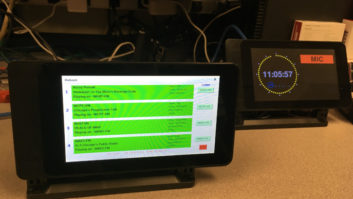In this column, we often talk about remote control applications with newer pieces of gear that support SNMP. However, I also know that there is a lot of gear out there too old for that. This time around we�re going to see how to apply newer remote control features to older gear.
The script on the rack room remote control energizes the T-R relay, and keys the TX; when through, it un-keys the TX and then releases the T-R relay. Before we go on, you may be asking: �What is the advantage here? Why bother with SNMP?� Well, there are two primary reasons to do so:

? Remote control wiring can be greatly simplified. At some point, this is going to make your job easier.
? Gain the ability to add ancillary devices to your graphic user interface. As long as there is IP connectivity between the two points (one being your primary remote control and the other being an ancillary device), the ancillary device can show up on the GUI.
The basic remote control features are ON and OFF, of course, and the status that indicates when the device is actually ON or OFF. It�s pretty easy to achieve this with a very basic SNMP setup. Analog readings are a bit harder to come by; not as many devices will read analog voltages.
There are at least three familiar remote control manufacturers that support SNMP signaling: with Burk, you could use the Arc Plus Touch and auto pilot; another choice is Audemat CONTROL and scripteasy; and finally, Davicom, using DV-mini, among others. If you use one of these three devices as your primary remote control, you�ll be able to add on SNMP control to ancillary devices.
From my own experience, I can tell you about two devices that are particularly friendly to SNMP signaling: the Broadcast Tools I/O Sentinel 4 and the Site Sentinel 4. Both devices provide relay outputs that can be controlled via SNMP (think remote push button) and status inputs that can be read by SNMP.
REAL LIFE APPLICATIONS
The B-T i/o sentinel, seen at left, allows the remote keying of the Marti TX by way of a GUI on the rack room remote control. Consider this example. I have a remote two-way base station transmitter that normally gets keyed up by editors in our news department. However, when in the field, testing a receiver at one of our receive sites, I don�t want to bother them to key this two-way. By way of an SNMP-capable remote control, I can access our network (via VPN) and using the GUI, key it myself. This is an instance of when SNMP can make your job easier.

Let me give you another example of the kind of ancillary control done via SNMP.
What I wanted to do was to build a very basic, backup remote control that operates via a satellite connection (actually a VSAT terminal) that has limited IP bandwidth. Here�s the thing to remember: This backup control actually lives in our rack room, but its remote control outputs and inputs on are the other end of the vsat connection. In this case, I configured the remote control and the Site Sentinel 4 to �talk� to one another via the vsat connection, providing remote pushbuttons and remote status; therefore, I was able to not only back up the �normal� remote control at the site, but the connectivity as well.
With reductions in staff and increases in the number of sites many of us have to maintain, having remote controls that access other devices via the same GUI can be very, very helpful. You can be in two places at once.












